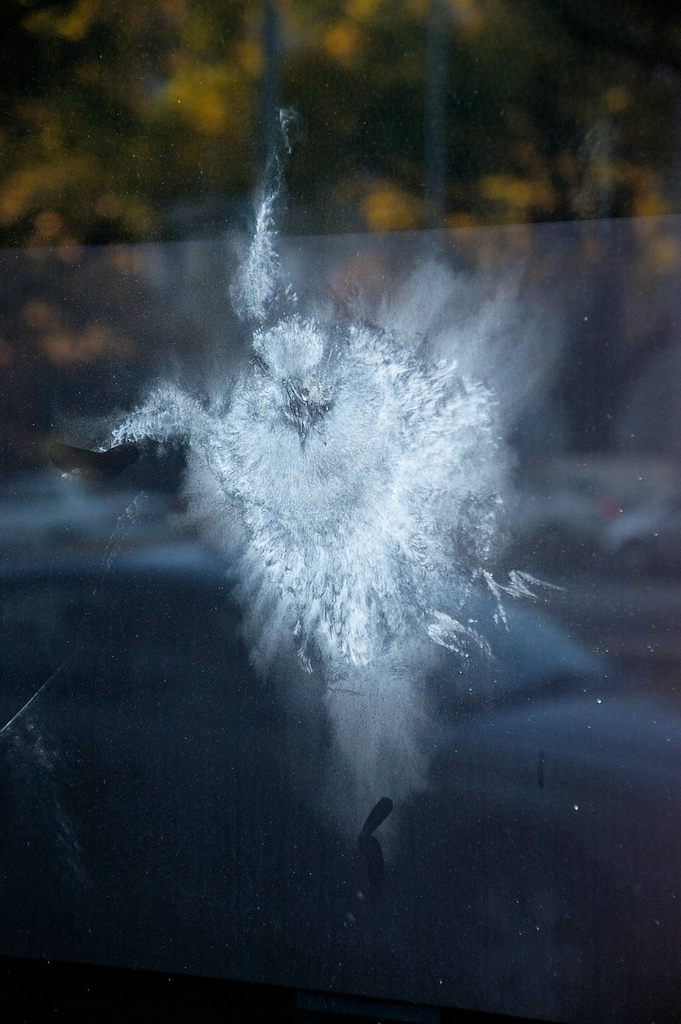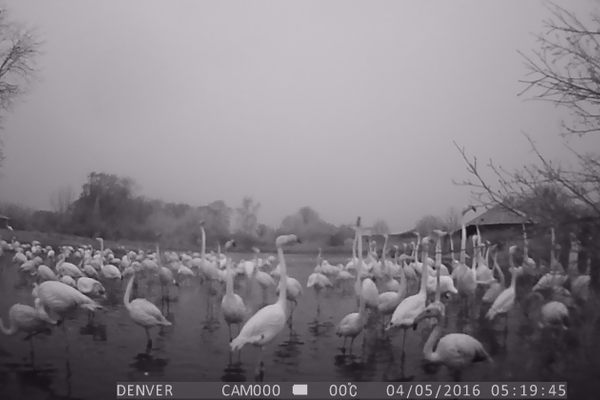Gorgeous, Gruesome Reminders to Bird-Proof Your Windows
When doves and pigeons collide with glass, they leave haunting images behind.

Back in 2007, Walt Snyder returned to his home in Maryland and found that someone else had recently tried to get in, too. On the window of his living room, spread out over the glass, was an eerie imprint of a mourning dove in flight—wings outstretched, head down, each individual feather perfectly clear. “I thought it was some kind of message from God,” he says. “But my brother told me, ‘It’s just a damn bird that hit your window.’”
Every day, all over the world, lots of damn birds hit windows. Although some survive these crashes, most do not—a 2014 study calculated that in the United States alone, collisions with man-made structures kill between 365 and 988 million birds per year, which averages to over a million birds per day. (This makes buildings the country’s second-most-prolific bird killers, behind cats.) Many of these birds die without anyone noticing—they just tumble down to the nearest curb or group of bushes, and are lost.
As a last act, though, some leave ghostly imprints—and thus, brief reminders of how they departed the earth.

“Birds tend to hit windows for a couple of reasons,” says Tania Homayoun, who manages the urban conservation team for Audubon Texas. The first has to do with light—at night, strong beams from searchlights or LED uplighting can dazzle birds into flying into buildings.
The second is glass-related: the more reflective and transparent a window is, Homayoun explains, the more likely a bird is to mistake it for additional habitat. “They think, ‘Oh, I can fly right through this!’” she says. “And they just crash right into that window.”

This is easy enough to imagine. Looking at an imprint, though, makes the understanding visceral—you can practically hear the beak hitting the glass, and see signs of the bird rearing back as it realizes its mistake. “I was fascinated by the amount of detail I found in the imprints, and the violent nature of the strikes,” says Snyder. Despite his interventions, a few more mourning doves were later brought down by his windows, and he began taking photos of the traces they left behind.
Soon after, he started contributing to the Flickr group “Bird Imprints on Glass,” which contains hundreds of such photos, submitted by people around the world. Some—like the shot at the top of the article, of a pigeon imprint on a glass walkway in Duluth, Minnesota—reflect the state of our infrastructure, which, Homayoun says, is getting increasingly bird-unfriendly. “This particular bird must have hit the glass at a pretty high rate of speed,” says the photographer, Tom Shearer. “If there was such a thing, feather prints could have been taken.”

Others tell a story in themselves: One amazing entry foregrounds a window streaked by desperate flapping, while in the background, a crow retreats, abashed.
“Most are factual representations of what occurred—some with more detail than others,” says Snyder, who is now the group’s administrator. As Homayoun explains, that level of detail generally has to do with the birds’ species. Imprints are made of dust from “powder down”—a type of feather that, rather than growing to a certain size and then falling out, disintegrates from the tip downwards.

“They form this oily powder,” says Homayoun. Only certain bird families produce powder down, which explains why, despite the diversity of birds who meet their deaths via window, pigeons and doves tend to be the ones that leave a mark.
If you would rather your window not become a bird memoryscape, you have a couple of options. You can put up bug screening or solar screening, which tend to keep birds from getting confused. Or you can use what Homayoun calls the “two by four rule”—put a tight grid of stickers or markings on your windows, making sure each is spaced four inches or less apart horizontally, and two inches or less apart vertically.

This will ensure the birds don’t see a sticker, move over a few inches, and still crash: “People will often buy one or two decals on this huge plate glass window and think everything is fine,” she says. “That’s like putting a potted plant in the middle of a room and expecting it to keep people out.”
Or, if you’d rather, Snyder offers another solution: “You can stop washing your windows,” he says. “I haven’t had [a strike] in at least five years.”
Naturecultures is a weekly column that explores the changing relationships between humanity and wilder things. Have something you want covered (or uncovered)? Send tips to cara@atlasobscura.com.



















Follow us on Twitter to get the latest on the world's hidden wonders.
Like us on Facebook to get the latest on the world's hidden wonders.
Follow us on Twitter Like us on Facebook